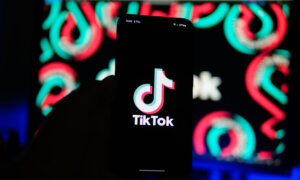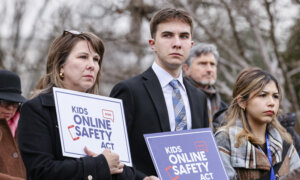A recent report by the Parents Television and Media Council outlined concerns related to the use of smartphones by students in schools and their associated mental health challenges, as well as the steps some states are taking to mitigate the issue.
The report released late last month underscores the growing consensus among educators, parents, and public health experts about the detrimental effects of unregulated smartphone use among children and teens, and raises concerns about impacts on academic performance, citing educators who have increasingly observed disruptions in the classroom due to phone use.
In the 1990s and early 2000s, experts in education policy issued warnings about the potential negative impacts of cellphones on the American classroom.
Melissa Henson, vice president of the Parents Television and Media Council, told The Epoch Times that this is an important issue today because of evidence that, in the years since students returned to in-person schooling post-COVID, there’s been a marked decline in social skills and classroom discipline. Henson noted, “Kids have lost a lot in terms of their ability to relate to their peers, in terms of their ability to deal well with authority figures.”
She also pointed out that the rise of smartphones and social media use in schools has led to “dramatic” increases in mental health issues, such as anxiety, depression, and suicidal thoughts among teens and preteens. Henson described this as a “perfect storm” that encourages disruptive behavior and even facilitates cheating, creating a challenging environment for learning.
Lawmaker Efforts
The report’s release falls on the same day that the Smart Kids Not Smartphones Act, a bipartisan effort to limit students’ use of cellphones in the classroom, was launched by Sens. Mitt Romney (R-Utah) and Chris Murphy (D-Conn.).The bill proposes to create an award program run by the Department of Education that would recognize schools that have implemented and strictly enforced a policy that forbids students from using smartphones during class time.
“There is no question that smartphones are a major distraction to students in the classroom,” Romney said in announcing the bill. “They also contribute to deteriorating mental health, social isolation, and cyberbullying among our youth. Our bill would encourage schools to institute policies which would prohibit the use of smartphones during class time, while still allowing for reasonable exceptions for emergencies, educational activities, and students with exceptional needs.”
Murphy cited concerns about students’ long-term outcomes with excessive use of smartphones in classrooms: “Smartphones in the classroom are a massive distraction from learning and socializing with other students, and feed into our kids’ addiction to technology. There are plenty of schools, including in Connecticut, that have seen improved student mental health and academic outcomes after implementing policies that limit phones in the classroom.”
Bill Salak, chief technology officer of Brainly, an online education platform, argued against the ban, saying in a statement on the brand’s Facebook page, “I take the opposite stance here, because I think that banning cellphones is, at best, a missed opportunity, and at worst, maybe not worse, but one of the more harmful results that I can predict is that it will actually produce a group of kids who aren’t prepared to be productive in society.”
A number of states have already made some effort to curb the use of cellphones in the classroom, ranging from some states that have banned the use during instructional time and others that have legislation pending on the issue.
The Parents Television and Media Council’s report cited a fall 2023 survey by the Pew Research Center that found that 72 percent of U.S. high school teachers identified cellphone distraction as a significant problem. Middle and elementary school teachers also expressed concerns, with 33 percent and 6 percent, respectively, noting similar issues.
Additionally, a 2018 study by Rutgers University-New Brunswick found that students who used cellphones for nonacademic purposes during lectures performed worse on end-of-term exams. Similarly, a study by the London School of Economics indicated that even the mere presence of a smartphone could lower test scores for nearby students by approximately 16 percent.
Healthy Technology Usage
Despite these concerns, the report acknowledges that implementing and enforcing cellphone bans can be challenging. While 77 percent of U.S. schools have adopted policies prohibiting cellphones for nonacademic purposes, enforcement is inconsistent, particularly in high schools. The report notes that the responsibility often falls on teachers, who may lack the resources or support to enforce such policies effectively.The report also addresses common objections to school cellphone bans. It argues that while phones can be useful for emergency communication and organization, they are often more of a crutch than a helpful tool. The report suggests alternative solutions, such as encouraging students to memorize important numbers and use traditional planners.
While the Parents Television and Media Council encourages schools and lawmakers to step up to make the change to cellphone policy, Henson pointed out that it has proved to be a difficult policy to implement, even where it already exists, and said she believes that it is ultimately up to parents to model healthy technology usage.
“Parents need to be encouraging their kids to be fully present and fully engaged in their schools and in their classes,” Henson said. She said it is “critically important” that parents “be very intentional and stow away those devices and connect with our kids, and not just sit there on the couch, scrolling for hours on end.”
“It’s important for us as parents to model the behavior we want to see from our kids.”














